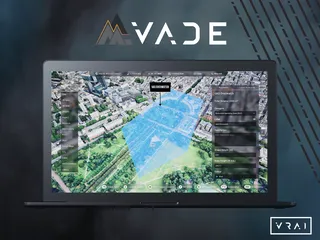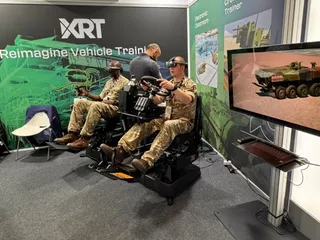DSEI 2025 – Prepared for 20-40-40?
Contact Our Team
For more information about how Halldale can add value to your marketing and promotional campaigns or to discuss event exhibitor and sponsorship opportunities, contact our team to find out more
The Americas -
holly.foster@halldale.com
Rest of World -
jeremy@halldale.com

MS&T’s Special Correspondent Andy Fawkes reports on DSEI 2025, 9-12 September.
Walking through London’s ExCeL Centre this September, it felt that DSEI 2025 was more than an exhibition, it was a vision of the UK’s “20-40-40” force strategy. Drones of all shapes, sizes and types were there and seemingly more so on the stands of nations physically closer to Russia. Overall, there was less emphasis at DSEI on manned vehicles and aircraft, and more on remotely operated, digitally enhanced, and mass-producible systems. The 20-40-40 strategy itself, widely reported by various news outlets in May 2025 and repeated in the UK’s SDR paper in June, advocates for building a force of 80% unmanned and remote operated capability split equally between one way and reusable systems, and 20% traditional crewed heavy platforms (like tanks). This strategic shift, prioritising drones, AI, and autonomy, draws urgent lessons from contemporary conflicts, notably Ukraine.
Largest DSEI Ever
With ExCel’s new extension, DSEI 2025 was largest to date, and I certainly physically felt the size of the show with the half-mile walk end to end amongst a myriad of large and small exhibitors. Its theme of “Preparing the Future Force” focused attention on how digital transformation, supply chain agility, and workforce adaptation are reshaping armed forces. Over 1,750 exhibitors, including 18 of the West’s top 20 defence companies, and more than 60,000 visitors were expected across the four days. New for 2025, the Tech Zone hosted 101 companies with 42% of exhibitors new to the event, underlining the arrival of non-traditional defence suppliers.
Simulation and Convergence
The convergence of simulation both technologically and its usage was demonstrated at DSEI, with AI, data, and game engines driving rapid advances. Simulation was no longer presented as a support tool but as a central enabler of training, planning, and even live operations. What struck me most was not a single breakthrough, but the way different companies were approaching the same challenge from complementary directions.
Accenture described its work on its AI-driven environments designed to compress planning cycles and bring coherence across domains, including an AI agent framework that could rapidly generate behaviours straight from doctrine. Their role, as they presented it, was less about owning technology and more about integrating disparate systems to generate complex scenarios that can adapt in real time. A similar focus on adaptability came from the Spectre initiative, demonstrated by Hadean and its partners. A high TRL system aimed at commanders and operational planners, Spectre integrates various external data feeds and uses simulation to predict future scenarios allowing defence to plan, refine and execute in a more integrated and agile manner. Also, exploiting simulation beyond training, VRAI used DSEI to launch its Virtual All-Domain Environment (VADE) mission planning tool. Developed in collaboration with UK forces, VADE provides rapid 3D immersive mission visualization, briefing, and rehearsal capabilities through its Unreal Engine software, and can switch between XR and flatscreen views. Such tools can ingest near real-time geospatial data from partners like Cesium and Ordnance Survey UK and on this theme, Maxar demonstrated its "Raptor" capability, which leverages its 25 years of data collection to provide high-fidelity geospatial data and 3D models. With satellites capturing images down to 30 cm fidelity it can even enable drones to use computer vision to navigate as a backup against GPS jamming.
Anduril stressed the importance of simulation in developing and validating autonomy at scale. Swarming behaviours, resilience in contested domains, and the concept of achieving battlefield “mass” are all stress-tested in simulation before deployment. Cohort’s MASS, meanwhile, emphasised the human dimension, describing how working with partners such as Hadean and Antycip, its joint training simulation (JCAST) includes civilians, information operations, and social media effects. Antycip highlighted how its VR Forces constructive simulation, part of the MAK ONE suite, is not only used in JCAST but is used in Monte Carlo simulations for operational analysis and AI experimentation.
In a more training-specific context, Elbit Systems UK emphasised the role of its Joint Fire Synthetic Trainer (JFST) in maintaining operator competence. Offered as both a full dome and a deployable syste, it can help maintain competence even during operational deployments. Physical training sites, too, are being transformed by simulation. At Copehill Down Village, 4GD has instrumented facilities with sensors and after-action systems that allow simulated effects to be overlaid on live exercises, and all designed using the Unreal engine.
AI and Data
Artificial Intelligence was not overtly visible at DSEI 2025 but speaking to the exhibitors it is cutting across everything from guiding drones and loitering munitions to accelerating operational planning. For the training community, the discussion was more about how AI and data can transform preparation. VRAI highlighted its HEAT analytics engine, which captures and processes performance data from training environments to provide evidence-based insight into trainee development. Similarly, 4C Strategies showcased how its Exonaut allows outputs from exercises to be organised into readiness dashboards, providing commanders with visibility of competence and gaps across units and individuals. Discussions revealed that AI has enormous potential to automate and enhance, but its effectiveness depends on the availability and integrity of data.
Panel Sessions
There was a myriad of sessions to attend at DSEI with some focused on training. The ITEC panel addressed the question “Are we better at manufacturing equipment than talent?”. Panelists argued that the gap is partly structural and partly about risk appetite. High-end, “marquee” systems (e.g., F-35) justify long, standards-driven training pipelines, whereas rapidly evolving, largely disposable technologies demand shorter, “risk-savvy” approaches to training and currency. To compress training time, the panel urged a shift from one-size-fits-all courses to modular, individualised pathways with coaching, tackling the lean “people wastes” of unevenness and overburden. It recommended a pan-defence skills framework, a digital skills passport, convergence on a single learning/HR platform, and wider use of simulation to offset delays and capture performance data, with instructors upskilled for VR/AR and AI delivery. Greater permeability with industry, lateral entry, apprenticeships, zig-zag careers, and attention to trust, judgment, motivation, and wellbeing remain essential.
In the Royal Navy-focused “Digital as a training and learning enabler” session, the discussion described a shift from siloed, course-based training to a system approach with industry (Project Selborne/Team Fisher) together with academic support (University of Lincoln). Since December 2020 the programme has unified training across 14 sites into a single model, delivered in four three-year “epochs.” Central to transformation is the development of the Schedule Optimisation Engine (SOE), intended to manage individual learning journeys based on predictive data. The data for this system is managed within the defence digital ecosystem and will link via an API to defence learning (DLMC) and HR systems.
Drones and Training
Speaking with exhibitors and attendees, it was clear that impact of drones extends beyond hardware to training and support, with costs and time falling sharply, as some drone operators train in days rather than years. Drones spanned air, ground, surface, and subsurface systems (including fly–swim variants), raising a standardisation issue so warfighters do not need to learn or carry multiple controllers.
Skyeton reported a fielded fleet of ~600 fixed-wing ISR drones in Ukraine, parachute-recovered, with 30–40 hours endurance. Training follows a 30-day progression, one week theory with limited simulation, one week assembly, procedures, and parachute recovery, two weeks of live flying by two-person crews. The main burden is mission planning and coordination. Red Cat's Black Widow is a smaller ISR drone selected for the US Army’s, with ~45 minutes endurance and day/night sensors. Training is a three-day course covering familiarization, basic operation, and tactical employment. Control uses the Warfighter Electronic Bridge (WEB) running the ATAK UAS Tool, a reconfigurable common interface extendable to other air and ground systems, reducing cognitive load and easing cross-platform transfer.
Across manufacturers, three themes recurred: short training cycles, controller standardization, the relatively low cost of live flying versus high-fidelity simulation for early skills, and the shift from training the few to training at scale.
1,750 Exhibitors
It was impossible to speak to everyone at the show, but I want to thank the following for their time speaking to me and not already mentioned above: 4C Strategies, Arabelle Solutions, BAE Systems, Bluedrop, BMT, British Army, Capita, Coachmeplus, UK Cyber and Specialist Operations Command, D3A, Elastic, Evolve Dynamics, Hamersham, Helsing, MetaverseVR, Nordfen, Origin Robotics, Palantir, Reveal Technology, Royal Air Force, Royal Navy, UAVTEK and Varjo.
Onwards to DSEI 2027
DSEI returns to ExCeL London on 7–10 September 2027. What we will see in DSEI 2027 is very hard to predict given the current dramatic shifts. The current swing toward digitally enabled mass weaponry may be a blip and heavy and expensive platforms may strike back, although currently this seems to be unlikely. Either way, training and simulation must adapt swiftly to the new world of expressed through the 20-40-40 strategy. This will be challenging when existing training pipelines are very much tuned to the “20”, where can the time be found to train for all the new weapons and what will be new 20-40-40 doctrine that shapes that training?


